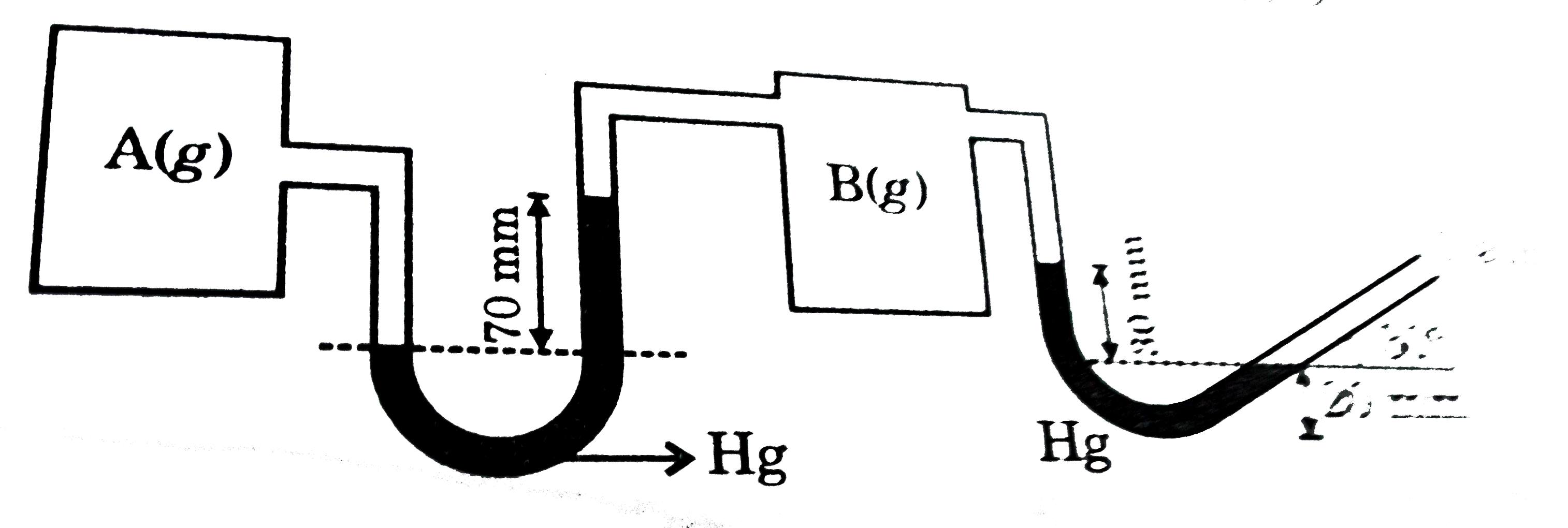Figure shows two vessels with adiabatic walls, one containing 0.1 g of helium (γ=1.67,M=4gmol−1) and the other containing some amount of hydrogen (γ=1.4,M=2gmol−1). Initially , the temperatures of the two gases are equal. The gases electrically heated for some time during which equal amounts of heat are given to the gases. It is found that the temperatures rise through the same amount in the two vessels. Calculate the mass of hydrogen.
 Solution in Tamil
Solution in Tamil
mHe=0.1 g,
γ1=1.67, MHe=4g/mol.
MH2=?, MH2=2g/mol,
γ2=1.4
Since it is an adiabatic surroundings
For He, dQ=nCvdT
=m2×Rγ−1×dT
0.14×R1.67−1×dT
For H2 , dQ=nCvdT
=m2×Rγ−1×dT
m2×R1.4−1×dT
[where m is the required mass of H2.] Since equal amount of heat is given to both, so, dQ is same in both Equations ...
(i) and ... (ii), we get
0.14×R0.67×dT
=m2×R0.4×dT
implies m=0.12×0.40.67
=0.0298=0.03g.
Topper's Solved these Questions
Similar Questions
A wave of wavelength 0.60 cm is produced in air and it travels at a speed of 300 ms^-1. Will it be audible?
08:11View SolutionThe gravitational force acting on a particle of 1 g due to a similar particle is equal to 6.67×10−17N. Calculate the separation between the particles.
02:37View SolutionLet n1 and n2 moles of two different ideal gases be mixed. If adiabatic coeefiecient of the two gases are γ1 and γ2 respectively, then adiabatic coefficient γ of the mixture is given through the relation
03:35View SolutionAt 300 K , two gases are filled in two equal sized containers as given What will be the pressure of A(g) (in mm of Hg) ?
04:02View SolutionAt 300 K two gases are filled in two equal sized containers as given

What will be the pressure of A(g) (in mm of Hg) ?View SolutionTwo identical vessels contain helium and hydrogen gases at same temperature, then
02:42View SolutionFreundlich equation for adsorption of gases ( in amount of x g) of a solid ( in amount of m g ) at constant temperature can be expressed as
04:46View SolutionConsider two sealed jars of equal volume. One contains 2 g of hydrogen at 200 K and the other contains 28 g of nitrogen at 400 K. The gases in the two jars will have -
View Solutionहिलियन तथा ऑक्सीजन गैसों के समान द्रव्यमानों को ऊष्मा की समान मात्राएँ दी गयीं । किसके ताप में अधिक वृद्धि होगी तथा क्यों ?
View SolutionFreundlich equation for adsorption of gases (in amount of x g) on a solid (in amount of m g) at constant temperature can be expressed as
03:27View SolutionThere are two thermally insulated vessel.One with 0.025 moles of helium and other with n moles of hydrogen.Initially both the gases are at room temperature.Now equal amount of heat is supplied to both the vessels. It is found that in both the gases temperature rises by same amount. Find the number of moles of hydrogen in second vessel.
View SolutionEqual masses of oxygen and helium gases are supplied equal amount of heat. Which gas will undergo a greater temperature rise and why?
03:43View SolutionA gaseous mixture enclosed in a vessel consists of one g mole of a gas A with γ=(53) and some amount of gas B with γ=75 at a temperature T . The gases A and B do not react with each other and are assumed to be ideal . Find the number of g moles of the gas B if γ for the gaseous mixture is (1913)
01:47View SolutionThere are two closed containers A and B Container A contains PCl3 gas at 25∘C temperature and 1 bar pressure. Container B contain equilibrium mixture of gases obtained by partial decomposition of PCl5 (g) at the same temperature and pressure. Assuming that initially equal mole of PCl5 (g) at same temperature and pressure . Assuming that initially equal moles of PCl5 were taken into the containers ( before decomposition ), the gases are allowed to effuse through a pinhole in the containers, Which container will show higher rate of effusion ? Justify .
View SolutionTwo identical vessels contain helium and hydrogen gases at same temperature, then
08:14View SolutionAt a given temperature, equal masses of monatomic and diatomic gases are supplied equal quantities of heat. Which of the two gases suffer a larger temperature rise?
05:27View Solution

